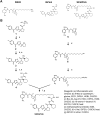The novel drug candidate S2/IAPinh improves survival in models of pancreatic and ovarian cancer
- PMID: 38493257
- PMCID: PMC10944456
- DOI: 10.1038/s41598-024-56928-z
The novel drug candidate S2/IAPinh improves survival in models of pancreatic and ovarian cancer
Abstract
Cancer selective apoptosis remains a therapeutic challenge and off-target toxicity has limited enthusiasm for this target clinically. Sigma-2 ligands (S2) have been shown to enhance the cancer selectivity of small molecule drug candidates by improving internalization. Here, we report the synthesis of a novel drug conjugate, which was created by linking a clinically underperforming SMAC mimetic (second mitochondria-derived activator of caspases; LCL161), an inhibitor (antagonist) of inhibitor of apoptosis proteins (IAPinh) with the sigma-2 ligand SW43, resulting in the new chemical entity S2/IAPinh. Drug potency was assessed via cell viability assays across several pancreatic and ovarian cancer cell lines in comparison with the individual components (S2 and IAPinh) as well as their equimolar mixtures (S2 + IAPinh) both in vitro and in preclinical models of pancreatic and ovarian cancer. Mechanistic studies of S2/IAPinh-mediated cell death were investigated in vitro and in vivo using syngeneic and xenograft mouse models of murine pancreatic and human ovarian cancer, respectively. S2/IAPinh demonstrated markedly improved pharmacological activity in cancer cell lines and primary organoid cultures when compared to the controls. In vivo testing demonstrated a marked reduction in tumor growth rates and increased survival rates when compared to the respective control groups. The predicted mechanism of action of S2/IAPinh was confirmed through assessment of apoptosis pathways and demonstrated strong target degradation (cellular inhibitor of apoptosis proteins-1 [cIAP-1]) and activation of caspases 3 and 8. Taken together, S2/IAPinh demonstrated efficacy in models of pancreatic and ovarian cancer, two challenging malignancies in need of novel treatment concepts. Our data support an in-depth investigation into utilizing S2/IAPinh for the treatment of cancer.
© 2024. The Author(s).
Conflict of interest statement
S.W., W.G.H. and D.S. filed an invention disclosure on the presented technology.
Figures






Similar articles
-
Conjugation to a SMAC mimetic potentiates sigma-2 ligand induced tumor cell death in ovarian cancer.Mol Cancer. 2014 Mar 7;13:50. doi: 10.1186/1476-4598-13-50. Mol Cancer. 2014. PMID: 24602489 Free PMC article.
-
The targeted SMAC mimetic SW IV-134 augments platinum-based chemotherapy in pre-clinical models of ovarian cancer.BMC Cancer. 2022 Mar 12;22(1):263. doi: 10.1186/s12885-022-09367-w. BMC Cancer. 2022. PMID: 35279106 Free PMC article.
-
Sigma-2 receptor ligand as a novel method for delivering a SMAC mimetic drug for treating ovarian cancer.Br J Cancer. 2013 Oct 29;109(9):2368-77. doi: 10.1038/bjc.2013.593. Epub 2013 Oct 8. Br J Cancer. 2013. PMID: 24104966 Free PMC article.
-
Targeted pancreatic cancer therapy with the small molecule drug conjugate SW IV-134.Mol Oncol. 2014 Jul;8(5):956-67. doi: 10.1016/j.molonc.2014.03.005. Epub 2014 Mar 26. Mol Oncol. 2014. PMID: 24731702 Free PMC article.
-
The Targeted SMAC Mimetic SW IV-134 is a strong enhancer of standard chemotherapy in pancreatic cancer.J Exp Clin Cancer Res. 2017 Jan 17;36(1):14. doi: 10.1186/s13046-016-0470-4. J Exp Clin Cancer Res. 2017. PMID: 28095907 Free PMC article.
Cited by
-
Trametinib Thwarts Activation of Survival Pathways Induced by Pro-ferroptotic Drug Conjugate ACXT-3102 Resulting in Enhanced Pancreatic Cancer Cell Death.Mol Cancer Ther. 2025 Jul 18:OF1-OF12. doi: 10.1158/1535-7163.MCT-24-1032. Online ahead of print. Mol Cancer Ther. 2025. PMID: 40676970 Free PMC article.
-
Recent Advances in the Development of Sigma Receptor (Radio)Ligands and Their Application in Tumors.ACS Pharmacol Transl Sci. 2025 Mar 7;8(4):951-977. doi: 10.1021/acsptsci.4c00711. eCollection 2025 Apr 11. ACS Pharmacol Transl Sci. 2025. PMID: 40242588 Review.
References
-
- Walker JM, et al. Sigma receptors: Biology and function. Pharmacol. Rev. 1990;42:355–402. - PubMed

